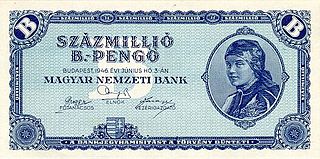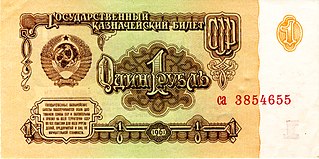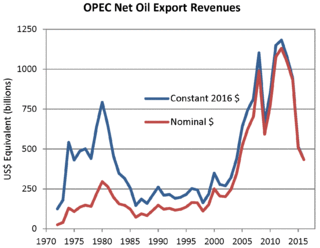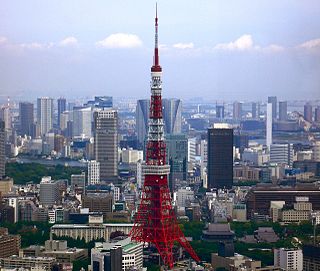Related Research Articles

In economics, hyperinflation is a very high and typically accelerating inflation. It quickly erodes the real value of the local currency, as the prices of all goods increase. This causes people to minimize their holdings in that currency as they usually switch to more stable foreign currencies. When measured in stable foreign currencies, prices typically remain stable.

In economics, stagflation or recession-inflation is a situation in which the inflation rate is high or increasing, the economic growth rate slows, and unemployment remains steadily high. It presents a dilemma for economic policy, since actions intended to lower inflation may exacerbate unemployment.

In economics, inflation is an increase in the general price level of goods and services in an economy. When the general price level rises, each unit of currency buys fewer goods and services; consequently, inflation corresponds to a reduction in the purchasing power of money. The opposite of inflation is deflation, a decrease in the general price level of goods and services. The common measure of inflation is the inflation rate, the annualized percentage change in a general price index. As prices faced by households do not all increase at the same rate, the consumer price index (CPI) is often used for this purpose. The employment cost index is also used for wages in the United States.

In economics, deflation is a decrease in the general price level of goods and services. Deflation occurs when the inflation rate falls below 0%. Inflation reduces the value of currency over time, but sudden deflation increases it. This allows more goods and services to be bought than before with the same amount of currency. Deflation is distinct from disinflation, a slow-down in the inflation rate, i.e. when inflation declines to a lower rate but is still positive.

Valentin Sergeyevich Pavlov was a Soviet official who became a Russian banker following the dissolution of the Soviet Union. Born in the city of Moscow, then part of the Russian Soviet Federative Socialist Republic, Pavlov began his political career in the Ministry of Finance in 1959. Later, during the Brezhnev Era, he became head of the Financial Department of the State Planning Committee. Pavlov was appointed to the post of Chairman of the State Committee on Prices during the Gorbachev Era, and later became Minister of Finance in Nikolai Ryzhkov's second government. He went on to succeed Ryzhkov as head of government in the newly established post of Prime Minister of the Soviet Union.

The Bretton Woods system of monetary management established the rules for commercial relations among the United States, Canada, Western European countries, Australia, and Japan after the 1944 Bretton Woods Agreement. The Bretton Woods system was the first example of a fully negotiated monetary order intended to govern monetary relations among independent states. The Bretton Woods system required countries to guarantee convertibility of their currencies into U.S. dollars to within 1% of fixed parity rates, with the dollar convertible to gold bullion for foreign governments and central banks at US$35 per troy ounce of fine gold. It also envisioned greater cooperation among countries in order to prevent future competitive devaluations, and thus established the International Monetary Fund (IMF) to monitor exchange rates and lend reserve currencies to nations with balance of payments deficits.
In economics, hot money is the flow of funds from one country to another in order to earn a short-term profit on interest rate differences and/or anticipated exchange rate shifts. These speculative capital flows are called "hot money" because they can move very quickly in and out of markets, potentially leading to market instability.
Foreign exchange reserves are cash and other reserve assets such as gold held by a central bank or other monetary authority that are primarily available to balance payments of the country, influence the foreign exchange rate of its currency, and to maintain confidence in financial markets. Reserves are held in one or more reserve currencies, nowadays mostly the United States dollar and to a lesser extent the euro.
A transition economy or transitional economy is an economy which is changing from a centrally planned economy to a market economy. Transition economies undergo a set of structural transformations intended to develop market-based institutions. These include economic liberalization, where prices are set by market forces rather than by a central planning organization. In addition to this trade barriers are removed, there is a push to privatize state-owned enterprises and resources, state and collectively run enterprises are restructured as businesses, and a financial sector is created to facilitate macroeconomic stabilization and the movement of private capital. The process has been applied in China, the former Soviet Union and Eastern bloc countries of Europe and some Third world countries, and detailed work has been undertaken on its economic and social effects.

The ruble or rouble was the currency of the Soviet Union. It was introduced in 1922 and replaced the Imperial Russian ruble. One ruble was divided into 100 kopecks. Soviet banknotes and coins were produced by the Federal State Unitary Enterprise in Moscow and Leningrad.

Petrodollar recycling is the international spending or investment of a country's revenues from petroleum exports ("petrodollars"). It generally refers to the phenomenon of major petroleum-exporting states, mainly the OPEC members plus Russia and Norway, earning more money from the export of crude oil than they could efficiently invest in their own economies. The resulting global interdependencies and financial flows, from oil producers back to oil consumers, can reach a scale of hundreds of billions of US dollars per year – including a wide range of transactions in a variety of currencies, some pegged to the US dollar and some not. These flows are heavily influenced by government-level decisions regarding international investment and aid, with important consequences for both global finance and petroleum politics. The phenomenon is most pronounced during periods when the price of oil is historically high.

The Latin American debt crisis was a financial crisis that originated in the early 1980s, often known as La Década Perdida, when Latin American countries reached a point where their foreign debt exceeded their earning power, and they could not repay it.

The Lost Decade was a period of economic stagnation in Japan caused by the asset price bubble's collapse in late 1991. The term originally referred to the 1990s, but the 2000s and the 2010s have been included by commentators as the phenomenon continued.
After the dissolution of the Soviet Union in 1991 and the end of its centrally-planned economy, the Russian Federation succeeded it under president Boris Yeltsin. The Russian government used policies of shock therapy to liberalize the economy as part of the transition to a market economy, causing a sustained economic recession. GDP per capita levels returned to their 1991 levels by the mid-2000s. The economy of Russia is much more stable today than in the early 1990s, but inflation still remains an issue. Historically and currently, the Russian economy has differed sharply from major developed economies because of its weak legal system, underdevelopment of modern economic activities, technological backwardness, and lower living standards.
Inflation rate in India was 5.5% as of May 2019, as per the Indian Ministry of Statistics and Programme Implementation. This represents a modest reduction from the previous annual figure of 9.6% for June 2011. Inflation rates in India are usually quoted as changes in the Wholesale Price Index (WPI), for all commodities.

The 1922–1924 monetary reform of the Soviet Union was a set of monetary policies which was implemented in the Soviet Union as a part of the Soviet government’s New Economic Policy. The principal objectives of the reform included stopping the effects of hyperinflation, establishing a unified medium of exchange and the creation of a more-independent central bank.
The Romania–IMF relations span for more than 40 years, during which Romania had two economic systems: Soviet-type economic planning of the 1970s and 1980s and capitalism since the 1990s. The IMF had a strong role in shaping the Romanian economy of the 1990s towards neoliberalism.

The 1976 sterling crisis was a currency crisis in the United Kingdom. Inflation, a balance of payments deficit, a public spending deficit, and the 1973 oil crisis were contributors.
The Republic of Kazakhstan is a successor state of the former Soviet Union. According to the IMF, Kazakhstan maintains a good balance of payments ratio and looks relatively stable economically. Under Article IV of the IMF's Articles of Agreement, the IMF has the obligation to "exercise surveillance" over its policy members. This means that they look after the economic, financial, and exchange rate policies of its members, including Kazakhstan and meet approximately once a year with Kazakh government and national bank officials.
Vietnam joined the International Monetary Fund (IMF) on September 21, 1956, under the policy of Article VIII. Their quota contributes an estimated SDR of 1,153 millions and voting power of 0.24%. As of August 2016, the current IMF Resident Representative to Vietnam is Jonathan Dunn.
References
- ↑ Black, Miles; Hashimzade, Nigar; Myles, Gareth, eds. (2009). "money overhang". A Dictionary of Economics (3rd ed.). Oxford Reference website: Oxford University Press. doi:10.1093/acref/9780199237043.001.0001. ISBN 9780199237043.
- ↑ Tooze, Adam (September 16, 2021). "How China Avoided Soviet-Style Collapse". Noema. Los Angeles: Bergruen Institute.
- ↑ Cottareli, Carlo (June 1991). "IMF Working Paper No. 91/55: Forced Savings and Repressed Inflation in the Soviet Union: Some Empirical Results". International Monetary Fund. SSRN 884851.